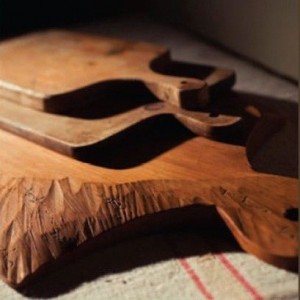And we're BACK! After some unhip technical difficulties, the Hipcycle blog is up and running!
Decisions, decisions. Paper or plastic? (Even better- bring your own bag!) Medium or large? Hot or cold? Wood or plastic.... cutting boards?
These days, we seem to be constantly bombarded by information and recommendations from so-called experts about just about every choice we make. Whenever someone is referred to as an expert, it makes us feel as though we can trust and believe everything that they say. Unfortunately, some “experts” focus only on studies that confirm their theories, rather than take all data into consideration. Add to this the possibility that they may be sponsored by certain companies to sway their professional opinions, and you wander who in the world you can really trust!
I’m not an expert on... anything, really. But I do my research to make informed choices. Today I’m going to share with you what I’ve found about cutting boards, in the hopes of helping you make an informed decision about which type is better for your family.
Plastic cutting boards have some benefits that wooden boards lack. Since the material is naturally non-porous, bacteria is unable to soak down into the board, and can thus be cleaned off with hot, soapy water followed by sanitizing. This is why the FDA has mandated the use of plastic cutting boards in commercial food establishments.
It is also fairly inexpensive, and dishwasher safe. Even on the sanitizing cycle, however, water must reach 190 degrees for at least a few seconds to actually disinfect, much higher than the recommended setting for a hot water heater.
These types of cutting boards, however, tend not to last very long. Since bacteria can lodge and spread in any nicks or cuts on a plastic cutting board, they must be thrown away when they get worn. Also, since plastic is made partially from crude oil, it’s not really a very eco-friendly choice.
Wood cutting boards, on the other hand, are made from a renewable resource. Hipcycle carries wood cutting boards made from reclaimed wood, which makes them doubly eco-conscious. In addition, the finishes are provided by nature or are otherwise eco-friendly and completely non-toxic.
However, wooden cutting boards are indeed significantly more expensive than their plastic counterparts. Wood cutting boards can literally last multiple lifetimes, though (my mother has her grandmother’s wood cutting board), and even when they are covered in gashes, may be planed down and used again and again.
A 1994 study at UC Davis (by Ak, Cliver, and Kaspar) found that bacteria is actually drawn into the wood (keep reading!) of a cutting board, where it can no longer reproduce and thus dies. This study also found that the bacteria often dies within minutes. Unfortunately, there really haven’t been very many scientific studies on this topic.
Whether or not bacteria indeed does die within a wood cutting board, with proper care, this type of kitchen essential is just as sanitary as the plastic alternative. Personally I clean mine with hot soap and water and sanitize with a spray down (and air dry) with pure white vinegar. Eventually I got tired of throwing away cheap plastic cutting boards (not to mention feeling guilty about the waste) and asked for a wood cutting board for Christmas. Mine were made by a handy uncle, from wood reclaimed from an old barn on the family farm- thanks Uncle Mike!
If you are on the market for eco-friendly, wood cutting boards, check out our selection. Many are made from wood originally used in the 1800s, and are so beautiful that I don’t think I would ever put them in a cabinet!
What are your thoughts- wood or plastic?



